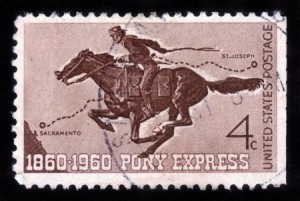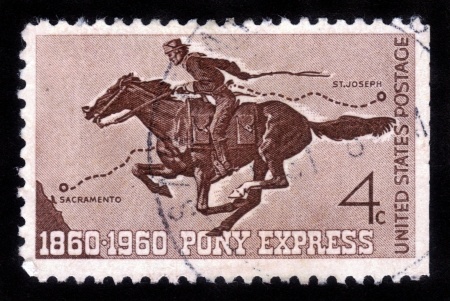
The Pony Express is a fixture of American history. William “Buffalo Bill” Cody’s time as a Pony Express rider initiated his eventual branding as a legend of the American West. Despite the obstacles it had to overcome, the Pony Express was remarkably efficient. During its short life of 18 months of operation, only one bag of mail was reported lost. As daring as the idea of an overland mail delivery route was in 18th century America, it has two historical precedents; one which has a biblical connection.
With war on the horizon and the traditional Southern mail route by stagecoach in jeopardy, there was an urgent need for a fast central-route mail service. “It was this demand that gave rise to the idea of the Pony Express.” There are several YouTube videos that describe the Pony Express. Here is one made from stock footage from a 1950s educational film. It has an illustrated map of the route and some helpful descriptions of what went into the operation of the Pony Express route.
In April of 1860, the Central Overland California & Pike’s Peak Express Company established an overland deliver route of mail from St. Joseph Missouri to Sacramento California that took about ten days. Each rider rode 75 to 200 miles and changed horses every 10 to 15 miles. The route was almost 2,000 miles long and had about 190 stations. Then on October 24, 1861, the East and West coasts were connected by the transcontinental telegraph system. Two days later, the Pony Express announced it would close down its services. It couldn’t compete with the almost instantaneous communications of the telegraph.
During the short time of its operation, the Pony Express completed a total of 308 runs and delivered 34,753 letters; only losing the one bag of mail. The recruitment poster for Pony Express riders read: “WANTED. Young, skinny wiry fellows; not over eighteen. Must be expert riders, willing to risk death daily. Orphans preferred.” When hired, the riders were required to take the following pledge. Those who violated the oath were terminated.
I [name], do hereby swear, before the Great and Living God, that during my engagement, and while I am an employee of Russell, Majors & Waddell, I will, under no circumstances, use profane language; that I will drink no intoxicating liquors; that I will not quarrel or fight with any other employee of the firm, and that in every respect I will conduct myself honestly, be faithful to my duties, and so direct all my acts as to win the confidence of my employer. So help me God.
Genghis Khan was noted for a horse relay postal system that covered the expanse of his empire. It has been said that this system “was instrumental in the expansion of the Mongolian Empire.” A letter could travel from the eastern end of the route near the Caspian Sea to the far western edge in two weeks, a distance of 4,225 miles. In Mongolia, postal riders continued to deliver the mail until 1949, when the former Soviet Union shut down the system while attempting to erase the memory of Genghis Khan from the history of Mongolia.
However, before Genghis Khan in 1224, the Persian Empire of the 5th century BCE was renowned for its communication system, one with striking similarities to the Pony Express. The Greek historian Herodotus said there was no swifter form of human communication at the time than the Persian system. There were men and horses stationed along the route so that each horse and man would be responsible for the interval of a day’s journey. The first rider delivered his charge to the second rider, the second to the third, and so on.
These are stopped neither by snow nor rain nor heat nor darkness from accomplishing their appointed course with all speed.
The biblical connection occurs in the book of Esther. We first see where King Ahasuerus (Xerxes) sent letters to all the royal provinces with a decree regarding conduct within a man’s household. This was after Queen Vashti refused to be paraded in front of Xerxes’s banquet guests (Esther 1:10-22). Haman later successfully convinced Xerxes to issue an edict calling for the destruction of all the Jews in the Persian Empire, and sent it by courier (Esther 3:9-13) to all the provinces of the kingdom. After Haman’s plot was uncovered and he was put to death, Xerxes sent letters “by mounted couriers riding on swift horses that were used in the king’s service, bred from the royal stud” (Esther 8:10) saying that the king permitted the Jews to defend themselves by whatever means necessary and destroy anyone who would attack them.
Although God is not explicitly mentioned anywhere in Esther, it is clear from the story that he was always with his people. And the message for us today is that he continues to guide and protect us even as he defended his people in the time of Esther. Neither snow nor rain will stop him. He is faithful through heat and darkness.





